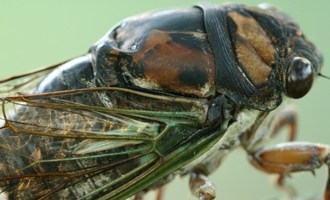URBANA, Ill. — Cicada killers (Sphecius speciosus) are solitary wasps with yellow banding on their abdomens. They appear in late July and early August and resemble large, black hornets.
Pros and cons
These insects are considered beneficial because they help control the annual cicada (Tibicen spp.) population. However, the excavating and burrowing that they do in open, dry ground when constructing their nests can be a nuisance for gardeners and homeowners.
Cicada killers are usually non-aggressive, although the male may investigate a person who invades its territory to determine that it is not another male cicada killer. Males are unable to sting. The females can sting but do so only when handled or disturbed because they lack the instinct to guard their nest as the honey bee does.Signal
The singing of the annual cicadas causes the adult wasps to come above ground out of hibernation. On their search for annual cicadas they will stop and drink nectar and water from gardens.
Once the female cicada killer has found and paralyzed a cicada, she will carry it back to her underground nest. She places her prize in a nest cell, lays her eggs on it and seals up the cell. The larvae hatch in a few days and begin to feed upon the cicada before they form a cocoon to pupate for the winter and early spring. Suggestions. For gardeners concerned about the safety of children or pets, University of Illinois Extension suggests planting ground covers and grass to prevent bare spots, adding mulch, and using irrigation to deter nesting. An application of a carbamate-based chemical product to the nest will kill cicada killer adults and their larvae, but killing this beneficial insect is discouraged.Here’s a short video of the wasp in action
STAY INFORMED. SIGN UP!
Up-to-date agriculture news in your inbox!











We have a few nest in our front yard. They scare the neighbors and kids. How do we get rid of them. I tried the soapy water technique. They came back the next day from a new hole. Lol! Any ideas?
You can swat them with tennis or badminton racquets. They fly slowly and are easy to hit. It may look brutal, but at least you won’t be using poisonous chemicals.
Pour ammonia down into the opening of the nest using a funnel to get as deep as possible. You have to do it after dusk when they return to the nest. Mark the area early in the day so you can find it in the dark. You’ll hear them buzzing when you pour enough in. Then cover up the hole with the muddy dirt.
Guess you people did not read that they are beneficial. But hey, just kill them because they look scary. Stupid humans.
Bahahahaaaa!!!! Funny Robert. I have decided to leave mine bee (pun intended)
I’m only getting rid of them because they’re tearing up the underside of the sidewalk and driveway.
I only WACK the males, its done wonders for my backhand. I do love watching the females do their thing. Carrying those cicadas is something to see and appreciate. Amazing 👏 🙀 😮
I’ve got about 10-12 holes in the yard. I use the water hose make the dirt around the hole not look so noticeable. Today one of the adults came out and I stomped on with my size 12 shoe four times. For sure I the thing was dead! Hell no it was still moving!!! I watched it for about 5 minutes gain it’s composure and ended up flying off. Later I found a paralyzed cicada so I’m guessing they Heffa is one tuff Killer. Hahaha
Mosquito Joe in Pine Bush will eliminate Cicada Killers (as well as other stinging insects) if you want them removed. I do agree they aren’t generally aggressive unless they feel threatened.
845-410-0011.
I have them every year. I have 12 nest in my shrubs where the dirt is soft to dig in. If they kill cicadas, the more wasp i have the happier I am. I will never kill any of the ones I have. I walk around them all time doing yard work. We don’t mess with each other.